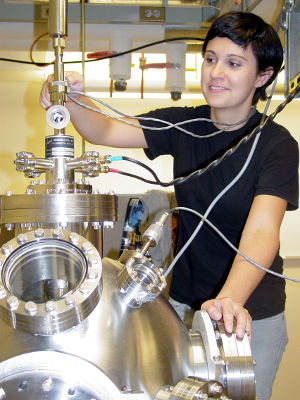Scaling up the production rate of nanofibers by understanding the fundamental physics:
Development of novel fabrication methods which enable increased throughput while still generating high-quality nanofibrous materials (i.e. sub-micron fiber diameters with a narrow fiber distribution) represents a critical goal for facilitating broader industrial utilization of these polymeric materials. A host of applications ranging from tissue scaffolding for biomedical applications, as sensors, in air and water filtration systems, or acting as "smart" fabrics would benefit from such capability.
- Towards this end, we have demonstrated solution-phase electrospinning from an unconfined fluid near a plate edge will produce small diameter fibers with a narrow size distribution, and has remarkable similarity to traditional single-needle electrospinning while also possessing clear advantages for increased mass throughput.
- This concept has been extended by electrospinning from a stationary, thin-lipped fluid-containing bowl. Our paper detailing this experiment has been downloaded >2969 times according to the journal website metrics (link) [as of 08/22/23]
- Further, by utilizing highly-conductive polymer solutions (through the introduction of a salt additive), electrospinning can actually be achieved from extremely narrow jets without exhibiting a linear region and subsequently a vastly increased whipping region, enabling continuous fiber production from radially-pointing jets, with each having an extremely high feed rate -- the combined consequence is of an overall tremendously enhanced nanofiber production rate.
- Notably, the edge electrospinning approach is a general enough method that polymer melts can also be readily electrospun using the open, unconfined configuration, creating a scaled up, solvent-free fabrication system, allowing truly environmentally "green" processing of commercial thermoplastics to generate mesoscale fibers.
- Further research is being pursued to extend such a melt electrospinning approach to produce nanofibers of commerically-relevant thermoplastics. The importance of the roles that conductivity versus viscosity plays when utilizing such highly-viscous systems to achieve nanofiber production is a current focus of our work.
- We have recently shown that multiple different chemically-compatible additives can be used with polyethylene to raise the melt conductivity and thereby, create a larger fraction of nanofibers during unconfined electrospinning.
- N. Sheoran, B. Boland, S. Thornton, J. R. Bochinski, and L. I. Clarke, "Enhancing ionic conductivity in polymer melts results in smaller diameter electrospun fibers," Applied Physics Letters 123, 074103 (2023). (journal)
- N. Sheoran, B. Boland, S. Thornton, J. R. Bochinski, and L. I. Clarke, "Increasing ionic conductivity within thermoplastics via commercial additives results in a dramatic decrease in fiber diameter from melt electrospinning," Soft Matter 17, 9264 (2021). (journal)
- Q.-Q. Wang, C. K. Curtis, N. M. Thoppey, J. R. Bochinski, R. E. Gorga, and L. I. Clarke, "Unconfined, melt edge electrospinning from multiple, spontaneous, self-organized polymer jets," Materials Research Express 1, 045304 (2014). (journal) [paper]
- N. M. Thoppey, R. E. Gorga, L. I. Clarke, and J. R. Bochinsk, "Control of the electric field - polymer solution interaction by utilizing ultra-conductive fluids," Polymer 55, 6390 (2014). (journal) [paper]
- M. P. Roman, N. M. Thoppey, R. E. Gorga, J. R. Bochinski, and L. I. Clarke, "Maximizing spontaneous jet density and nanofiber quality in unconfined electrospinning: the role of inter-jet interactions," Macromolecules 46, 7352 (2013). (journal) [paper]
- N. M. Thoppey, R. E. Gorga, J. R. Bochinski, and L. I. Clarke, "The effect of solution parameters on spontaneous jet formation and throughput in edge electrospinning from a fluid-filled bowl," Macromolecules 45, 6527 (2012). (journal) [paper]
- N. M. Thoppey, J. R. Bochinski, L. I. Clarke, and R. E. Gorga, "Edge electrospinning for high throughput production of quality nanofibers," Nanotechnology 22, 345301 (2011). (journal) [paper]
- Nagarajan Muthuraman Thoppey, J. R. Bochinski, L. I. Clarke, and R. E. Gorga, "Unconfined fluid electrospun into high quality nanofibers from a plate edge," Polymer 51, 4928 (2010). (journal) [paper]
